Bacteria Powered Solar Cell Sample Assignment
FEASIBILITY STUDY OF BACTERIA POWERED SOLAR CELL FOR FUTURE POWER GENERATION
1. INTRODUCTION
1.1 Energy
Energy is the fundamental source of life. It is present everywhere, however, it needs to be converted to particular forms in order to make it usable by humans. Energy accessible to humans is broadly divided into two types depending upon the availability of the amount of the source. Some forms of energy are in-exhaustible and will be available for practically unlimited period of time while others are very limited and may end up soon on excessive usage. These two broad categories are renewable and non-renewable sources of energy. Out of it, the area of interest is the non-renewable sources of energy since they are sustainable and cheaper than its counterpart. As such, it is a need to harness these sources and convert them into usable form. The technology to convert different forms of energy such as wind energy, solar energy, tidal energy etc. into the usable form of electrical energy has evolved continuously in the past hundred years with improvements in the design and the results being an increase in the efficiency during this process to get maximum amount of electrical energy. [7]
1.2 Solar Energy
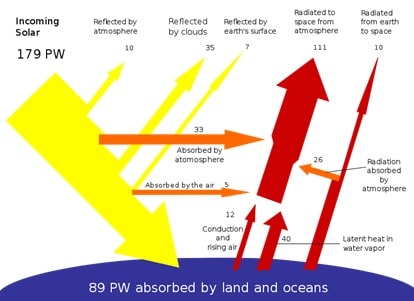
Sun is the biggest and most easily accessible renewable source of energy. As such, solar energy has the biggest potential to replace fossil fuels for the generation of electrical energy. The UN said in its World Energy Assessment in 2000, that Solar energy can potentially provide 1,500 - 50,000 EJ of energy annually whereas the required demand is only 600 EJ in 2012. Hence, this sector deserves utmost attention for its technological development through research and analysis. If achieved, it will cut down the environmental pollution due to burning of fossil fuels completely, provide essentially never exhausting source of energy, cut down costs of energy production and benefit the entire global population in numerous other ways. [2]
1.3 Electricity Generation
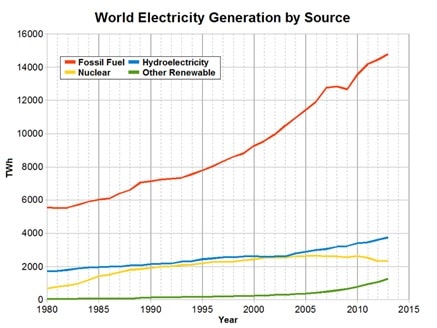
Electricity generation refers to the methods of producing electricity using primary sources of energy such as fossil fuels, sun, wind and other means. This generated electricity can then be transferred through transmission lines across large distances and used for a variety of essential purposes. As such, electricity is an essential part of human lives in this era. The demand for electricity has increased though a large number in the past few decades. As such, production of electrical energy needs to meet the demands which asks for more generators with more supply of the raw materials, generally fossil fuels. However, it also means an increase in pollution, creating a major problem for the environment. The solution could be an increased use of renewable energies such that the dependence on non-renewable sources could be ended completely. [1]
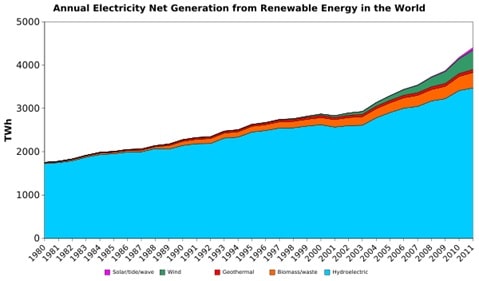
Solar energy can be harnessed using Solar Cells. These cells are exposed to the sun’s ray, and through some processes, convert the sunlight or solar energy into transmissible electrical energy. Although, the use of solar cells has increased widely, the efficiency of these cells still has a lot of room for improvement. As such, with the advancement in technology, the expectations are very high from this source of energy. [3]
2. WORKING OF A SOLAR CELL
2.1 Solar cell

A solar cell, also known as a Photo Voltaic (PV) Cell, is an electrical device which is used to convert the sun’s energy in the form of sunlight, into electricity [10]. This is possible because of the photovoltaic effect. The solar cells are generally made up of semiconductor materials which behave in a special way on exposure to sun light and give off electrons which is used for the flow of electricity. The diagram shows the basic structure of a solar cell, comprising of two differently charged plates due to the exposure to the sun. This results in a current flow when the external circuit is completed. Although the electricity generated by a single 10x10 cm of solar cell is small, large number of these cells are usually combined to form huge ‘Solar panels’ spanning fields of land, such that maximum amount of sunlight may be trapped and used for production of electricity on a large scale.
2.2 Photovoltaic effect
Photovoltaic effect is a physical and chemical process in which a voltage difference is developed in specific materials when sunlight falls on them. As such, this can potentially be used for the flow of electric current and hence production of electricity. The materials which exhibit this photovoltaic property are generally semiconductors such as silica.
2.3 How is electricity produced
Solar cells use three processes to produce electricity. These are:
- Light absorption through the surface of the material, creating electron-hole pairs: The sunlight contains photons which have momentum due to the velocity of light, and hence can displace electrons in suitable materials from their position in the material creating an electron hole. This hole will then be filled by a positively charged ion.
- Separation of the positive and negatively charged carriers, thus creating a potential difference or voltage: The positively charged ion will travel from its position to the nearest electron hole and try to neutralize the negative charge generated. By separating the two opposite charges, a potential difference is created.
- Flow of these charge carriers through and external circuit, thus generating electricity: When the positively charged ion leaves its position, the flow of electricity is created and electricity generation is complete.
This process occurs numerous times as the photons continuously knock electrons out of their positions when exposed to sunlight and the electricity flows. Though a small exposed surface of a semiconductor material produces very weak flow of electricity, a large enough area is suitable to create large amounts of electricity for big cities. To achieve this, a wide area of land with good exposure to the sun and using other significant factors, is selected to develop into a solar energy farm. A string of solar panels is then laid on the ground at suitable angles to maximise the amount of light falling on it. These are then connected to the central storage and distribution lines.
3. ROLE OF BACTERIA IN PRODUCTION OF CURRENT
3.1 Functions of bacteria
Use of biological micro-organisms for the production of electricity has been studied in detail in the past decades for the same reason as that of the solar energy, that is its accessibility in abundance. The widely available bacteria can be used for digesting substances and through this degradation, electrons or ions along with some by products are released. If these electrons could be made to flow through an external circuit, electricity could be produced.
- Oxidation of water: The cyanobacteria used for this process produces hydrogen gas as a by-product, by oxidising pure water, especially free from nitrogen containing organic compounds. By this decomposition, electrons are released at the anode which is separated from the system using a semi-permeable thin film. This is transferred at the cathode with higher potential to complete the circuit.
- Reduction of anode: This type of solar cell utilizes replaceable anode sections for creating the oxidation reactions using sunlight as the source of energy for the photosynthesis. Again, electrons are produced as a result of this reaction and are transferred at the other end of the circuit to achieve electricity flow.
- Breakdown of organic material: This type of solar cell utilizes the decomposition of organic matter in the anodic medium by the bacteria. The organic matter needs to be put into the system after it has been used up, and as such require continuous maintenance which is not suitable for remote applications.
- Production of hydrogen for cathodic reactions: The microbial digestion of the organic matter produces hydrogen ions or protons which are reduced to hydrogen gas at the cathode. This gas can then be collected for further use and hence produces an environment friendly by-product of the system.
As such, the primary purpose of bacteria (cyanobacteria, E.coli or others) is to decompose some organic compounds through chemical reactions in the presence of sunlight to provide free electrons at the anode. Additionally, bacteria at the cathode could reduce the organic protons and hence accelerate the reactions at anode, thereby increasing the electricity generated through a biogenic solar cell.
4. PREVIOUS ATTEMPTS
The field of production of electricity through the use of biological means has been extensively studied in the past, and the efficiency of such cells have thereby been increasing at a steady pace. Bacteria powered cells generally use photosynthesis to produce by products and electrons. The use of these electrons or by products is then done to produce electric current. We will study the different types of Biological solar cells which have been made with considerable results.
- Biological Photovoltaic (BPV) cells: These are biological electrochemical cells which are used to convert light energy into electricity. It works by the photolysis of water at the anode and a high potential generating chemical reaction at the cathode in the presence of living organisms, thereby creating a potential difference and generating electricity. Since the bio-organisms are able to regenerate themselves, these type of cells can potentially be used to generate electricity indefinitely using the sunlight as a source of energy for photosynthesis.
- Biological solar cell using Gold anode: This was an advancement in the setup of the biological solar cells, which now uses a thin strip of gold anode or indium tin oxide. The problem was again, however, the amount of electricity produced. The technology used could produce a trillionth of a watt of electricity per square centimetre of the setup. Hence, to power a handheld calculator, it would require 250km long and 20m wide strip of the setup. Also, the setup is not open to air which means that the bacteria used would eventually die due to lack of it.
- Improved Biological solar cell with carbon anode: A researcher from the Binghamton university made an advancement in the anode structure of the existing cell. The gold anode was replaced with a carbon anode, the setup was modified and the anode was kept in an open flask, with access to the atmosphere. As a result, the lifespan was increased to about a year as well as the efficiency was improved significantly. This new setup could power the calculator with a 20m by 5m strip, since it produced a million times higher energy.
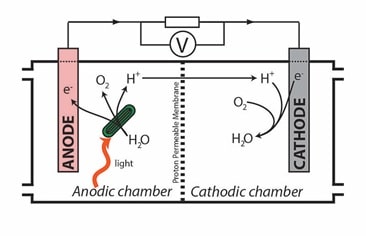
As an example of these type of cells, we can study the biological photovoltaic fuel cell, which uses water and sunlight as the only input. In the anode side, water is oxidised to its components and electrons are released. The higher potential at cathode then drives these electrons in an external circuit resulting in flow of electricity. If water can somehow be regenerated, it will only need sunlight as input. Also, at cathode, the protons released can be combined to release hydrogen gas which will be useful by product of the process.
The problem with these type of cells is the amount of electricity produced, which is currently too low to be considered feasible. It can be improved through modifications of the bacteria through genetic engineering, which is being studied thoroughly. Also, the medium used for keeping the bacteria can be modified to achieve greater lifespan of these type of cells, and even to accelerate the processes performed by the bacteria by providing favourable conditions.
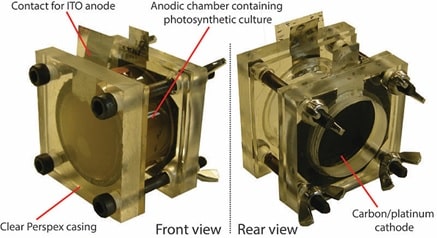
Though a great advancement, this new cell is still not viable for general use. [12]
5. NEW BIOGENIC SOLAR CELL
5.1 Type 1
Biogenic solar cells are evolving continuously with each advancing year in an effort to increase the efficiency and feasibility. A recent study in 2018 developed solar cells with double the production of electricity than the existing ones. The study was carried out by researchers from the University of British Columbia (UBC). [4]
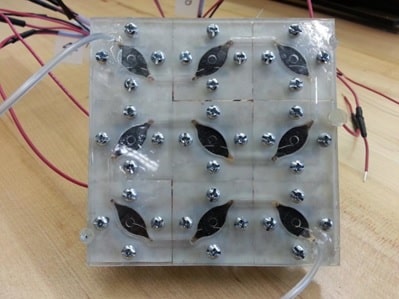
This newly developed technology utilizes biologically engineered bacteria with advances setup to produce higher amount of electricity. The bacteria which was used is the readily available E. coli bacteria. It was modified genetically to mimic the carotenoid biosynthetic pathway existing in plants. This modification produced a strain in the bacteria which results in the overproduction of a pigment named ‘lycopene’. It is a photoactive pigment which is also present in tomatoes and watermelon and is responsible for their bright red colour. The activated pigment producing cells are then coated with a thin film of TiO2 through a super molecular interface. These cells are used to make the anode of the solar cell. The medium used for the cell to transfer electricity is an iodine based dye. [13][14]
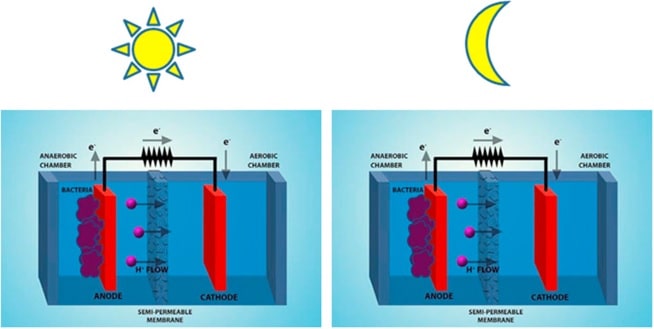
The lycopene dye which was produced by these bacteria using sunlight degrades with time producing electrons. On testing, it was found that the cells could generate as much as 0.686 mA of current per square centimetre of the setup. Also, this setup was easy to assemble and costs only a tenth of the existing ones. Also, the activated cells require only moderate exposure to light and as such are capable of producing electricity even under overcast conditions. [6]
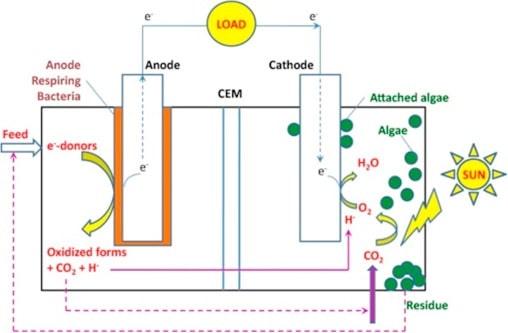
Diagram showing the flow of electrons generated at the anode being transferred to the cathode while the organic residue produced at the cathode after chemical reactions maybe fed back to the bacteria at the anode and hence it becomes a self-fulfilling cycle with reduced inputs and maximised outputs.
5.2 Type 2
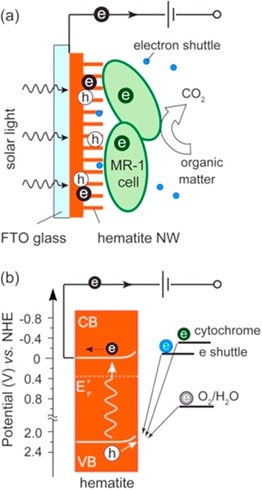
Another type of solar cell was developed by the researchers from the Vanderbilt university. [15] Referred to as the Bio-hybrid solar cell, it uses a combination inorganic and organic matter to produce electricity. The process used photosystem 1 protein complex to increase the efficiency of the process. The photosystem 1 cells are introduced in small quantities which then reproduce to form a thin green film. It is this film which helps to produce greater amounts of the electricity. The photosystem 1 cells were extracted from spinach, after first extracting the thylakoid membranes and then purifying it further. The amount of electricity generated improved by a thousand times using this modification. The efficiency of these type of cells in nearly hundred percent as compared to synthetic cells with only forty percent efficiency. Also, the use of simple compounds means that the cost of the cell is significantly lower than normal cells.
However, the electricity generated with these cells is still lower to be viable enough. Also, the cells do not last long with the maximum lifespan of about a year. [6]
6. ECONOMY
6.1 Measurement of feasibility
The economic feasibility of any electricity source is the most important factor which decides the level of importance it will be given for future research and development. This is because a very well performing and highly efficient energy source will not be of much use if it costs a major part of a country’s economy to run its systems. The output of an electricity source is generally measured in terms of kilowatt-hour or megawatt-hour. These include the costs of the system setup, subsidies provided by the government, fuel costs and the cost of maintenance of the setup.
The standard used for measuring the feasibility of different energy sources is the Levelized cost of energy (LCOE). It is calculated by dividing the average total cost required to setup and maintain an electricity production unit over its lifetime by the total amount of energy produced by the system over its lifetime.
6.2 Dependence of costs on different factors
Costs of the electricity production unit: The total cost of a unit is calculated taking into account the following factors: [8]
- Initial capital cost: it includes the cost of the machinery involved, mining of resources if done and purification, and the acquisition of land costs. This factor is lowest for fossil fuels and highest for tidal and nuclear energy production setups. The solar and wind energy farms fall in between these energy systems.
- Fuel cost: it includes the cost of fuel required for running the setup. This is obviously highest for fossil fuel setups which include coal and petroleum products. The renewable sources of energy generally have very low costs. Solar energy systems have zero cost in this factor since sunlight is completely free and in-exhaustive.
- Other costs: it includes waste disposal costs, maintenance costs and labour costs. It is also highest for fossil fuel type electricity production plants and lowest for solar and wind energy farms.
As can be seen, the net result is that the solar energy is the cheapest of all, especially once the installation process is complete owing to the fact that it requires little to no maintenance and fuel for its operation.
6.3 Data from studies
Comparison of costs for different energy sources is done every few years by organisations such as Lazard, Bloomberg and IRENA. The latest November 2018 data from Lazard shows that renewable energy sources have now become cheaper than the traditional fossil fuels. Energy generated through wind energy farms was calculated to cost $29/MWh while the cost of solar energy production units was $36/MWh. This was lesser than or equal to the costs of fossil fuel using systems which was $36/MWh. This is because of the decrease in the costs through advancement in technology. The price of solar energy systems has fallen by 17% while wind systems have fallen by 7% from the last year. Also, provided the government gives subsidies to promote this renewable source of energy, the costs of solar systems were as low as $32/MWH and that for wind was $14/MWh. [9]
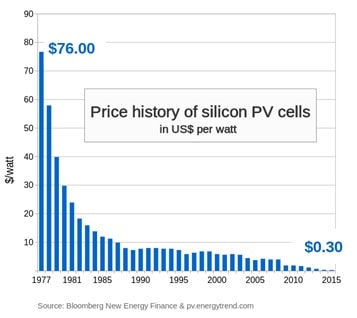
The Bloomberg also shows similar results. The cost of wind systems was reported as $55/MWh and that for solar photovoltaic systems as $72/MWh. This was again due to 18% decrease in prices in both these renewable sources in the past year.
Additionally, according to the International Energy Agency (IEA) data, the cost of solar photovoltaic panel setup has decreased significantly and is near to the more likeable price of $1/W. The current average price around the globe for residential setups is $3/W whereas commercial setups come at a discount at around $2.5/W. [11]
7. ENVIRONMENTAL FACTOR
7.1 Benefits
The new developments in the Biological solar cell technology has been very promising. The cells could be used to improve the efficiency of electricity production. The solar powered energy sources provide the following benefits:
- Pollution reduction: This is by far the biggest positive impact of the use of solar cells. The energy is produced using sunlight without the formation of any by-product. Hence there is air, water or noise pollution due to this mode of energy production. It replaces the traditionally used non-renewable sources of energy such as coal and petroleum products and by preventing their use, it brings down the carbon emissions and other forms of pollution due to fossil fuels. Also, the solar panels have better life than say coal plants and as such, they are sustainable in nature.
- Cost: Once installed successfully, solar panels are very low maintenance setups. Whether in the form of large fields of solar panels, or the more distributed private roof top panels, they last long and only require occasional cleaning. The significant initial investment can be further reduced by advancement in technology for setting up the structures. Also, subsidies and government help initiatives make it affordable for private households thereby significantly reducing the dependence on traditional electricity sources. As such, the costs of setting up a system has halved in the past three years.
- Safety and human health: The solar energy installations are completely safe to be present in human societies unlike any other energy production installations. There is no risk of radiations, toxic gas emissions or loud noise production.
- Bio-degradable: The biogenic solar cells are made up of eco-friendly materials and as such, can be easily recycled or decomposed after small procedures at the end of their life cycle. Hence they create minimum impact on the environment by reducing waste.
7.2 Disadvantages
With all these benefits of the solar energy, this technology also has significant drawbacks to it: [16]
- Land consumption: The small scale private solar panels for households have no impact on land use. They are the best option against this disadvantage. However, large scale solar energy farms require about 3.5 to 10 acres of land to produce a megawatt-hour of energy depending on the efficiency of plant and exposure to the sun. Also, unlike wind energy farms, these lands cannot be used for other secondary purposes such as farming or general use. [5]
- Use of water: The concentrated solar power plants (CSP) use conversion of water to steam, which is used to rotate turbines to produce electricity. A typical CSP requires about 600-650 gallons of water to produce a megawatt-hour of electricity. Though it is lower than other forms of thermal energy production plants, and the water used is not hazardous in nature, it still affects the water use of the area. This is because the solar energy farms are typically situated in dryer areas with abundance of exposure to the sun, and hence the water use of the plants should be monitored carefully to create a balance. [5]
- Hazardous materials during manufacture: The solar cell panels are made of semiconductor material, after a rigorous process of mining, purification, extraction and manufacture. All these process involves use of a number of chemicals depending upon the type of solar cell to be manufactured. These processes naturally produce a lot of hazardous waste as well as toxic emissions from the industries. Dumping of the by-products in the environment and improper recycling of the chemicals used for manufacturing affects the nearby locality and may even spread in large areas. Even with proper landfilling methods, the area maybe be rendered useless for agriculture, or even for residential purposes.
- Carbon emission during manufacture: After installation, the solar cells produce almost zero carbon emission because there is no by-product. However, during other processes of the lifecycle of the solar cell, carbon is emitted in the environment. This is mainly during the mining process for its raw components such as silica and from industries which manufacture the parts for the solar energy setups. Most studies average the carbon emission to be 0.08 to 0.2 pounds CO2 per kilowatt-hour of energy produced. However, this is much lower than natural gas (which is 0.6-2 pounds/kWh) and the non-renewable coal (1.4-3.6 pounds/kWh), and as such is the best alternative to replace the non-renewable sources of energy. However, the carbon footprint maybe further minimized through the use of biogenic solar cells instead of the conventional synthetic photovoltaic cells since the former uses only few parts to be manufactured industriously while most of the components are organic in nature. Also, the raw materials used are non-hazardous and can be recycled easily to form new systems.
- Recycling of old setups: Although the lifetime of solar panels is long, yet it will be rendered useless after it is complete. As such, it will need to be recycled and disposed off safely without harming the environment. Just like the automobile industry, where recycling plants were setup much after the setup of manufacturing plants, when the wastes began to accumulate; there is a need to look into this sector with the same lens and setup proper methods and techniques for effective recycling of the old solar panels and gain maximum output from the system.
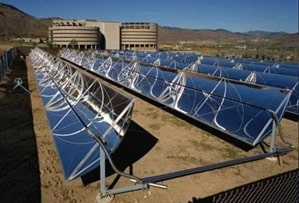
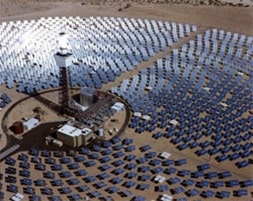
8. REFERENCES
- Image source: https://www.eia.gov/emeu/international/electricitygeneration.html
- Image source: https://en.wikipedia.org/wiki/User:User_A1
- Image source: https://www.eia.gov/beta/international/
- https://phys.org/news/2016-04-energy-bacteria-powered-solar-panel.html
- https://www.ucsusa.org/clean_energy/our-energy-choices/renewable-energy/environmental-impacts-solar-power.html#.W_ryH7jhXIU
- https://www.sciencedirect.com/science/article/pii/S1364032118301448
- https://en.wikipedia.org/wiki/Electricity_generation
- http://www.ukerc.ac.uk/publications/a-review-of-electricity-unit-cost-estimates.html
- https://www.lazard.com/perspective/levelized-cost-of-energy-and-levelized-cost-of-storage-2018/
- http://www.chemistryexplained.com/Ru-Sp/Solar-Cells.html
- https://phys.org/news/2015-02-pursues-biological-solar-power.html
- https://www.designnews.com/materials-assembly/using-bacteria-convert-light-energy/39377071359263
- https://onlinelibrary.wiley.com/doi/full/10.1002/smll.201800729
- https://news.vanderbilt.edu/2012/09/04/spinach-power-a-major-boost/
- https://www.ucsusa.org/clean_energy/our-energy-choices/renewable-energy/environmental-impacts-solar-power.html#.W_ryH7jhXIU


